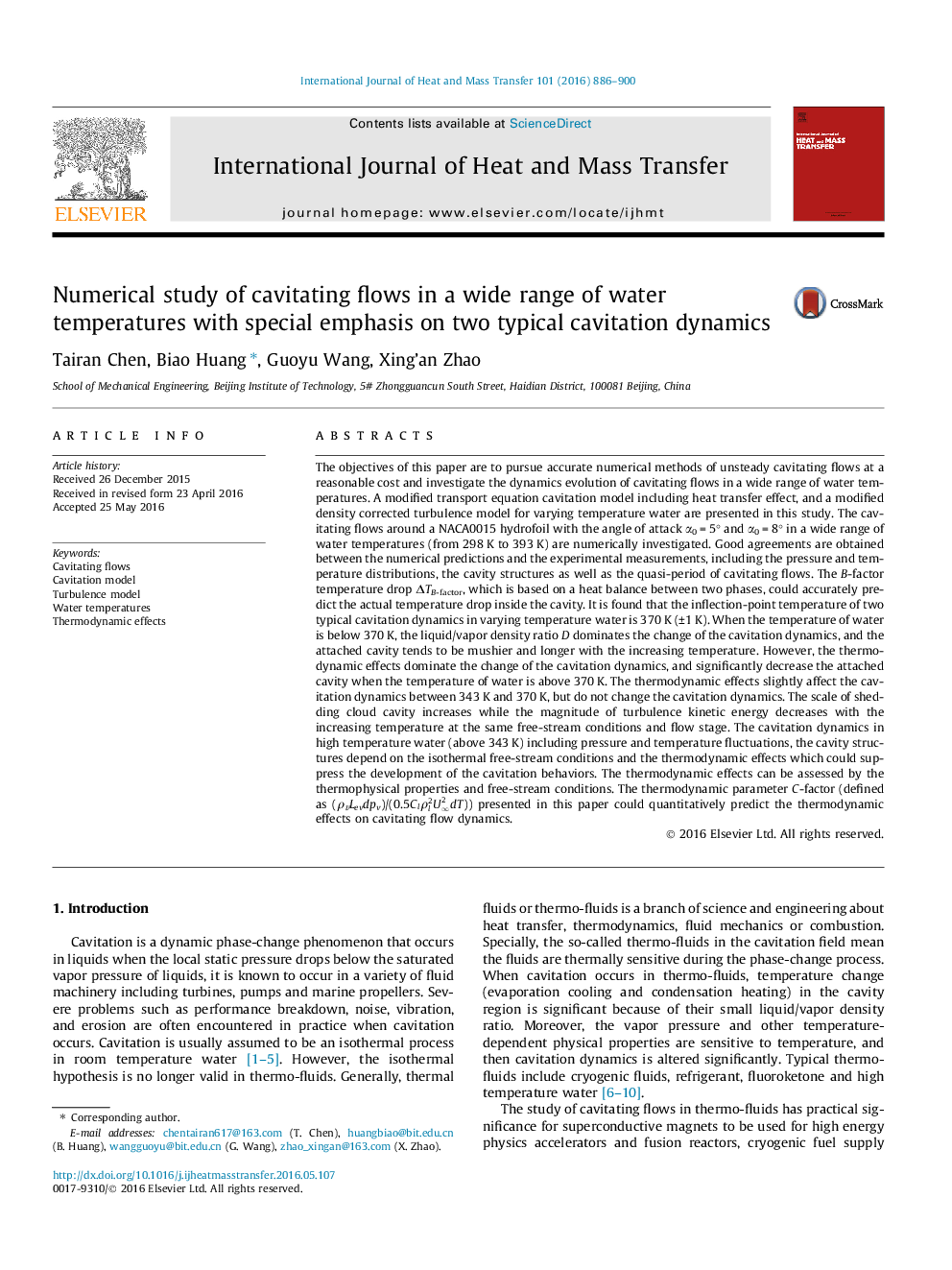| کد مقاله | کد نشریه | سال انتشار | مقاله انگلیسی | نسخه تمام متن |
|---|---|---|---|---|
| 7055402 | 1458041 | 2016 | 15 صفحه PDF | دانلود رایگان |
عنوان انگلیسی مقاله ISI
Numerical study of cavitating flows in a wide range of water temperatures with special emphasis on two typical cavitation dynamics
ترجمه فارسی عنوان
مطالعه عددی جریانهای حفره در طیف وسیعی از درجه حرارت آب با تأکید ویژه بر دو نوع پدیده کاویتاسیون معمولی است
دانلود مقاله + سفارش ترجمه
دانلود مقاله ISI انگلیسی
رایگان برای ایرانیان
کلمات کلیدی
حفره جریان، مدل کاویتاسیون، مدل آشفتگی درجه حرارت آب، اثرات ترمودینامیکی،
موضوعات مرتبط
مهندسی و علوم پایه
مهندسی شیمی
جریان سیال و فرایندهای انتقال
چکیده انگلیسی
The objectives of this paper are to pursue accurate numerical methods of unsteady cavitating flows at a reasonable cost and investigate the dynamics evolution of cavitating flows in a wide range of water temperatures. A modified transport equation cavitation model including heat transfer effect, and a modified density corrected turbulence model for varying temperature water are presented in this study. The cavitating flows around a NACA0015 hydrofoil with the angle of attack α0 = 5° and α0 = 8° in a wide range of water temperatures (from 298 K to 393 K) are numerically investigated. Good agreements are obtained between the numerical predictions and the experimental measurements, including the pressure and temperature distributions, the cavity structures as well as the quasi-period of cavitating flows. The B-factor temperature drop ÎTB-factor, which is based on a heat balance between two phases, could accurately predict the actual temperature drop inside the cavity. It is found that the inflection-point temperature of two typical cavitation dynamics in varying temperature water is 370 K (±1 K). When the temperature of water is below 370 K, the liquid/vapor density ratio D dominates the change of the cavitation dynamics, and the attached cavity tends to be mushier and longer with the increasing temperature. However, the thermodynamic effects dominate the change of the cavitation dynamics, and significantly decrease the attached cavity when the temperature of water is above 370 K. The thermodynamic effects slightly affect the cavitation dynamics between 343 K and 370 K, but do not change the cavitation dynamics. The scale of shedding cloud cavity increases while the magnitude of turbulence kinetic energy decreases with the increasing temperature at the same free-stream conditions and flow stage. The cavitation dynamics in high temperature water (above 343 K) including pressure and temperature fluctuations, the cavity structures depend on the isothermal free-stream conditions and the thermodynamic effects which could suppress the development of the cavitation behaviors. The thermodynamic effects can be assessed by the thermophysical properties and free-stream conditions. The thermodynamic parameter C-factor (defined as (ÏvLevdpv)/(0.5ClÏl2Uâ2dT)) presented in this paper could quantitatively predict the thermodynamic effects on cavitating flow dynamics.
ناشر
Database: Elsevier - ScienceDirect (ساینس دایرکت)
Journal: International Journal of Heat and Mass Transfer - Volume 101, October 2016, Pages 886-900
Journal: International Journal of Heat and Mass Transfer - Volume 101, October 2016, Pages 886-900
نویسندگان
Tairan Chen, Biao Huang, Guoyu Wang, Xing'an Zhao,
